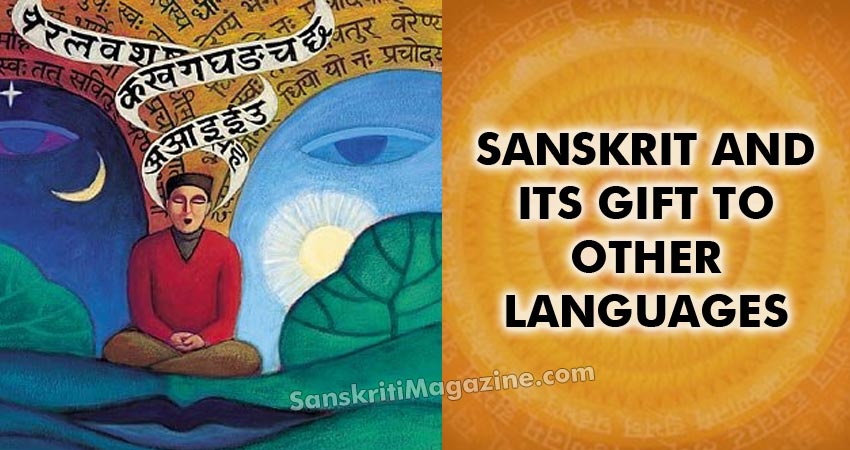One of the most important languages in the world, Sanskrit has a very rich and continuous known history of nearly five thousand years.
The “discovery of Sanskrit” by the West is usually associated with the memorable utterance of Sir William Jones in his third annual address before the Asiatic Society, Calcutta, on February 2, 1786:
“The Sanskrit language, whatever be its antiquity, is of wonderful structure; more perfect than the Greek, more copious than the Latin, and more exquisitely refined than either, yet bearing to both of them a stronger affinity, both in the roots of verbs and in the forms of grammar, than could not possibly have been produced by accident; so strong indeed, that no philologer could examine them all three, without believing them to have sprung from some common source which, perhaps, no longer exists; there is a similar reason, though not quite so forcible, for supposing that both the Gothick and the Celtick, though blended with a very different idiom, had the same origin with the Sanskrit; and the old Persian might be added to the same family”
Sir William Jones suggested for the first time in his book “The Sanscrit Language” that Greek, Latin and perhaps even Gothic, Celtic and Persian languages were related to Sanskrit. This discovery led to the comparative grammatical studies of various languages.
Since Proto-Indo-European language is only a theory and there is no solid evidence of a race or people who spoke this mysterious language, it is safe to say that Sanskrit is the Mother of all Languages. Even scholars like Voltaire, Kant etc., believed that Sanskrit was the root of all Indo-European languages.
Sanskrit served as a link language not only within India but even outside in the South-east Asian countries. Its influence on foreign languages and even on modem Indian languages has been vast and immense. Sanskrit was a polished language of the elite Brahmins, the Shista-s of Aryavarta and was confined to the orthodox literary circles, but it was propagated throughout the mainland of Asia up to Japan and China by the Buddhists, and to South-east Asia through Saivism and Vaishnavism by Brahmins, though some Smrti texts prohibit sea-voyage to the Brahmins as against their Varnasramadharma.
During the period of Buddhist propaganda and later of Hinduism the link language was Sanskrit. In spite of its sophisticated nature, Sanskrit was regularly taught in schools not only in India, but even abroad, mostly by Brahmins. In India also Sanskrit was the link language used in the different regions. Post-Vedic religious texts as well as texts on medicine, astronomy, philosophy, art and architecture, and important literary works were written directly in Sanskrit itself in spite of the development of regional language.
The importance of the study of Sanskrit goes far beyond the aesthetic value of its literature. Sanskrit is the key to most of the branches of the study of Indian civilization and the contribution of this civilization to the development of human thought and culture are considerable. The study of Indian classics is the foundation for the study of one of the major and ancient civilizations of the world.
One special feature of this Indian cultural inheritance is the unbroken continuity between the most modem and the most ancient phases of Indian thought extending for nearly 5000 years. Again, it is not an isolated existence. India had continuous and timely contacts with Babylonians, Iranians, Greeks, Egyptians, Chinese and Arabs, and has absorbed and assimilated the best from their civilizations without losing her own individuality.
‘If her basic culture survived these contacts, there must have been something in the culture itself which gave it the dynamic strength to do so, some inner vitality and understanding of life.’ ~ A.A. Macdonall
There are many words derived from Sanskrit to the English language, below are some examples of these borrowed words:
| Root Sanskrit Word | Median Word | Derived English Word |
| a (prefix “not” ex: gochara – agochara) | a (Latin)(Greek) (prefix “not”) | a (prefix “not” ex: theiest-atheist |
| Agni (Fire) | Ignis (Latin) | Ignite |
| Aksha (Axis) | Axon (Greek) | Axis |
| an (prefix “not” ex: avashya – anavashya) | un (Latin)(Greek) (prefix “not”) | un (prefix “not” ex: do-undo |
| Anamika (Anonymous) | Anonymos (Greek) | Anonymous |
| Arjuna (Charm of Silver) | Argentinum (Latin) | Argentinum – Scientific Name of Silver |
| Ashta (Eight) | Octo (Latin) | Eight |
| Bandh (bind around) | band, bandage | |
| Barbar (stammering) | Barbaros (Greek) | Barbarian |
| Barbara (Foreign) | Barbaria (Latin) | Barbarian |
| Bhrathr (Brother) | Phrater (Greek) | Brother |
| Chandana (Sandalwood) | Santalon (Greek) | Sandalwood |
| Chandra (Moon) | Candela (Latin) (light / torch) | Candle |
| Chatur (Four) | Quartus (Latin) | Quarter |
| Chitras (uniquely marked) | Cheetah | |
| Danta (Teeth) | Dentis (Latin) | Dental |
| Dasha (Ten) | Deca (Greek) | Deca |
| Dhama (House) | Domus (Latin) | Domicile |
| Dwar (Door) | Doru | Door |
| Gau (Cow) | Bous (Greek) | Cow |
| Ghas (eat) | Grasa (German) | Grass |
| Ghritam (Ghee) | ?? | Ghee |
| Hrt (Heart) | Herto (Proto Germanic) | Heart |
| Jaanu (knee) | Genu (Latin) | Knee |
| Jagannath (lord of the world) | Juggernaut | |
| Jan (Generation) | Genea (Greek) | Gene |
| Jutas (twisted hair) | Jute | |
| Kaal (Time) | Kalendae (Latin) | Calendar |
| Kafa (Mucus) | Coughen | Cough |
| Kri (To Do) | Creatus (Latin) | Create |
| Krmi-ja (red dye produced by a worm) | Cremensinus (Latin) Qirmiz (Arabic) | Crimson |
| Loka (Place) | Locus (Latin) | Locale |
| Lubh (Desire) | Lubo (Latin and Proto Germanic) | Love |
| Ma (Me/My) | Me (Latin) | Me |
| Madhyam (Medium) | Medium (Latin) | Medium |
| Maha (Great) | Magnus (Latin) | Mega |
| Makshikaa (Bee) | Musca (Latin) (Fly) | Mosquito |
| Mala (Dirt/Bad) | Malus (Latin) | Mal as in Malicious, Malnutrition, Malformed etc |
| Man (Ma as in Malaysia) (Mind) | Mens (Latin) | Mind |
| Manu (First Human) | Man/Men/Human | |
| Maragadum (Emerald) | Smaragdus (Latin) | Emerald |
| Matr (Mother) | Mater (Latin) | Mother |
| Mishra (Mix) | Mixtus (Latin) | Mix |
| Mithya (Lie) | Mythos (Greek) | Myth |
| Mrta (Dead) | Mortis (Latin) | Murder |
| Mush (Mouse) | Mus (Latin) | Mouse |
| Na (No) | Ne | No |
| Naama (Name) | Nomen (Latin) | Name |
| Naas (Nose) | Nasus (Latin) | Nose |
| Nakta (Night) | Nocturnalis (Latin) | Nocturnal |
| Nara (Nerve) | Nervus (Latin) | Nerve, Nervous |
| Narangi (Orange) | Naranj | Orange |
| Nava (New) | Novus (Latin) | Nova – New |
| Navagatha (Navigation) | Navigationem (Latin) | Navigation |
| Nila (Dark Blue) | Nilak (Persian) | Lilac |
| Paad (Foot) | Pedis (Latin) | Ped as in Pedestrial, Pedal etc |
| Pancha (Five) | Pente (Greek) | Penta, Five |
| Parah (Remote) | Pera (Greek) | Far |
| Patha (Path) | Pathes (Greek) | Path |
| Pippali (Pepper) | Piperi (Greek) | Pepper |
| Pithr (Father) | Pater (Latin) | Father |
| Prati | per (Latin) | per |
| Prati Shat (for every hundred, i.e percent) | per centum (Latin) | percent |
| Raja / Raya (King) | Regalis (Latin) | Royal |
| Sama (Same) | Samaz (Proto Germanic) | Same |
| Sama (Similar) | Similis (Latin) | Similar |
| Samiti (Committee) | committere (Latin) | Committee |
| Sapta (Seven) | Septum (Latin) | Seven |
| Sarpa (Snake) | Serpentem (Latin) | Serpent |
| Sharkara (Sugar) | Succarum | Sugar / Sucrose |
| Shunya (Zero) | Cipher (Arabic) | Zero |
| Smi (Smile) | Smilen (Latin) | Smile |
| Srgalah | Shagal (Persian) | Jackal |
| Srgalah (Jackal) | Shagal (Persian) | Jackal |
| SthaH (Situated) | Stare (Latin) (To Stand) | Stay |
| Sunu (Son or Offspring) | Sunu (German) | Son |
| Svaad (Tasty) | Suavis (Latin) | Sweet |
| Tha (That) | Talis (Latin) | That |
| They (th pronounced as in thunder, they) | Dei (Germanic) | They |
| Thri (Three) | Treis (Greek) | Three |
| Tva (Thee) | Dih | Thee |
| Upalah (Precious Stone) | Opalus (Latin) | Opal |
| Upalah (Precious Stone) | Opalus (Latin) | Opal |
| Vachas (Speech) | Vocem (Latin) | Voice |
| Vahaami (Carry) | Vehere (to Carry) (Latin) | Vehicle |
| Vama / Vamati (Vomit) | Vomere (Latin) | Vomit |
| Vastr (Cloth) | Vestire (Latin) | Vest |
| Vrihis (Rice) | Oriza (Latin) | Rice |
| Yaana (journey, wagon) | Wagen (German) | Van, Wagon |
| Yauvana (Youth) | Juvenilis (Latin) | Juvenile |











